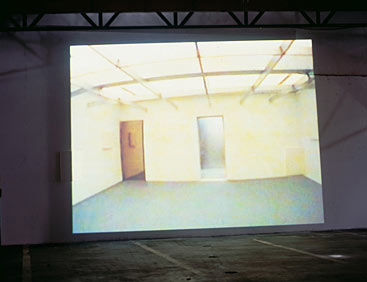
Born in 1964 in Brussels (BE)
Lives and works in Brussels (BE)

1996
Installation
Dimensions variables
Year of Purchase: 1996
Since the 1960s and 1970s, how works come into being and are set in a location and the viewing conditions are core issues in the creative process. The relationship to space has become a basic component of the work and a mode of critical appraisal of institutional art venues.
This reflection on the place or places where art is shown is a key feature in the work of the Belgian artist Alec de Busschère. His approach, close to minimalism (notably the physical presence of the viewer and the working drawing of the volumes), has moved on since 1991, from thinking on how the work is set in the exhibition space to the creation or reproduction of fictive places.
Alec de Busschère’s early work involved making various kinds of convex mirror-pictures which acted on the viewer’s perception by reflecting back a distorted image of the space. His work then moved towards the site-specific intervention, with full-scale reproductions of existing places which the artist would put back in their original space. Starting in 1994, Alec de Busschère went beyond the in situ concept, producing fictive places he just thought up.
This is the background to Under construction, a video installation dating from 1996, and first shown at the Palais des Beaux-Arts in Charleroi. This evolutive work is the outcome of a long process of collaboration among the different players involved (designated by anagrams of Alec de Busschère: Bruce Dehess, Herdès Cube, Breschee-sude). What was originally behind the design of this virtual space was just a list drawn up by the artist of the dimensions, materials and colours of some imaginary place. The production of that place was then delegated to writers, who were responsible for describing the spaces and their possible function, then to architects, who turned this written work into drawings and plans. At the end of this process, in the course of which the place picked up different modes of existence and representation, the artist produced models to the scale of 1:15, thereby lending concrete tangible form to this virtual space. The interior spaces and volumes of the scale models were then filmed with tiny cameras.
The images thus obtained are projected in the exhibition room, to the place’s own dimensions, to produce a superimposition of the imaginary (virtual) space on the actual space. This juxtaposition of a symbolic space alongside the one in which the artist ‘traditionally’ operates produces a shift whereby the container becomes the content, with the space itself becoming the work.
In producing this superimposition, Alec de Busschère refuses ideas of the place being neutral or self-standing in terms of the context of its appearance. This assertion is borne out by a device set in the middle of the room and which performs a rotational movement and projects the image of the virtual place in the round. The space moves around the viewer and its mobility means that the place is constantly being redefined.
Hélène Guenin